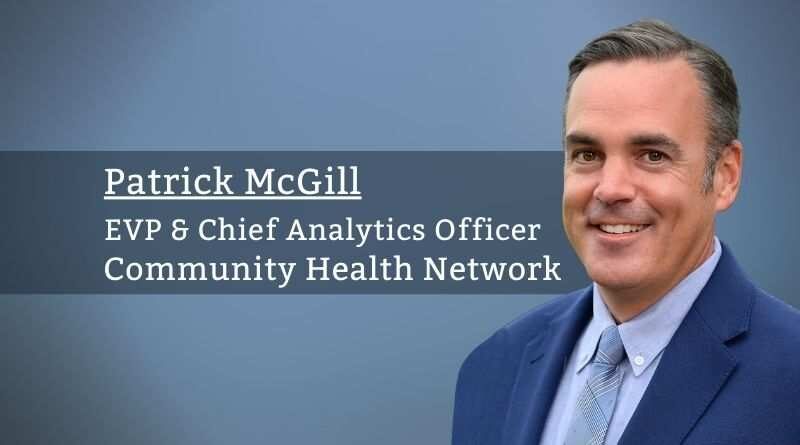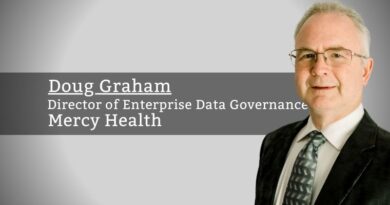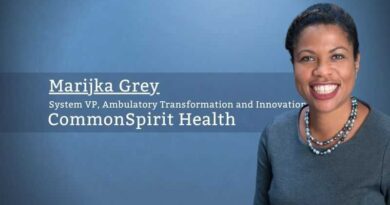Being data-driven leads to a new organizational structure
By Patrick McGill, MD., EVP & Chief Analytics Officer, Community Health Network
Many organizations aspire to be “data-driven’ or “analytics-focused,” but what do those terms really mean? Community Health Network was no different, embarking on a data and analytics improvement journey which resulted in a unique organizational structure: forcing form to follow function. “Form follows function” is a principle typically associated with industrial design, meaning the shape of an object should relate to its intended function or purpose. To extrapolate, how an organization is shaped ideally is directly related to the intended outcome.
After years of frustration with the lack of data or insights regarding how the business was performing, Community Health Network (CHNw), in the summer of 2018, engaged with Gartner to undergo an enterprise-wide evaluation of the function and future state vision regarding analytics as a strategic asset. Prior to this assessment, information was scarce despite data being abundant. The Analytics department, led by a Business Intelligence Director, was a subset of the Information Technology Department. There was a limited connection to the overall strategy of the business. Prioritization of projects and resources was either based on “first-come, first served” or by whichever Executive could strong-arm reports to be generated. Ultimately, this prioritization method led to operational units hiring their own data analysts which resulted in more silos as they did not have access to the central data sets.
As a result of the Gartner assessment, recommendations were made to create a freestanding Department of Network Analytics, headed by a new position; the Chief Analytics Officer (CAO). Additionally, as part of the new Analytics department, a Center of Excellence was formed. With the CAO reporting to the CEO, it ensured data and analytics had representation at the organization’s highest levels. The Analytics Center of Excellence was charged with reimagining how data was utilized within the organization and moving from mostly descriptive-analytical reporting to more advanced analytics, including predictive models powered by machine learning. Ultimately, the goal was to tie the network strategy to analytic output to inform business decisions with data.
After approximately nine months under this structure, additional organizational structures were put in place. Previously, all Information Technology functions reported under the Chief Operations Officer (COO) and Clinical Informatics activities fell under the Network Chief Physician Executive (CPE). In order to continue in advancing the desires of a data-driven organization, Information Technology, led by the Chief Information Officer, moved under the CAO. Additionally, Clinical Informatics, led by the Chief Medical Information Officer (CMIO), also moved under the CAO, along with Regulatory Reporting and all Enterprise Services including Business Process Management and Continuous Process Improvement.
Ultimately, after said changes, the Chief Analytics Officer has operational oversight of all network data and analytics (excluding finance), all technology and digital transformation, clinical informatics, process improvement activities, and regulatory reporting. This allows for direct connections between network strategy with analytics, technology, and business processes. In the truest sense of form following function, the organizational structure at Community Health Network is shaped to allow data to be a driver of network strategy by driving business outcomes.
After the pandemic passes, technologies such as electronic check-in, early hospital discharge programs, and remote chronic disease monitoring will quickly become the expectation for many patients and health systems.
In a year such as 2020, this structure has been incredibly beneficial. Early in the pandemic, data was scarce and technology needs were changing rapidly. For example, the conversation from a purely in-person care delivery model to a near 100% virtual model required expedient implementation of technology to support. The needs of measuring this new business delivery were no less important. Being able to predict volumes of covid infections and align with inpatient operational changes was critical. The strategy focused on preparation and taking care of infected patients while protecting our healthcare workforce.
As the pandemic continues to alter healthcare delivery, thus requiring continued use of virtual care and digital tools, the alignment of the support services with enterprise strategy will continue to be of utmost importance. After the pandemic passes, technologies such as electronic check-in, early hospital discharge programs, and remote chronic disease monitoring will quickly become the expectation for many patients and health systems.
Silos have long existed in many industries; healthcare is no different. Often, organizational structure contributes to the continued difficulty in communication and collaboration. As a result, three interventions will assist in the journey.
First, look at the organizational structure and understand if it is truly working. Historical and legacy structures, if in place for long periods should be examined. This is not to advocate that reorganization for the sake of change is the answer; however, taking a deeper examination into current structures is well worth the exercise.
Second, explore if non-traditional reporting structures might benefit the organization. Certainly, having the CIO report to the CAO is not typical. However, it is effective in our organization.
Third, ensure team members have a proper understanding of the strategy and vision of the organization. This is often an overlooked function with services typically considered supporting such as IT and Analytics. Additionally, helping them recognize the value in their work will also improve employee engagement.
Fourth, these functions need a consistent voice at the highest level of the organization. In order to be data-driven and truly digitally transformed, the employees responsible for this change must be earnestly represented throughout the process, not merely in appearance.
Finally, organizational structures are typically complex with legacy personalities. Finding the right structure to be data-driven can be challenging and demanding. It requires crucial but honest conversations. When performed with the organizational strategy and best interest at the center, the outcomes will be incredibly rewarding for all involved.



